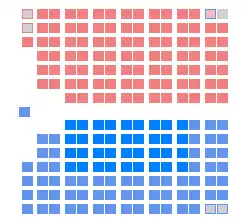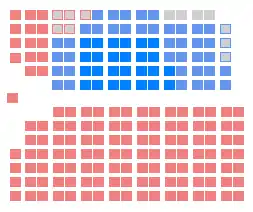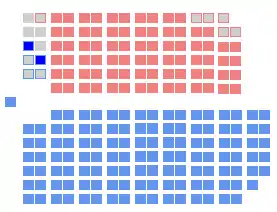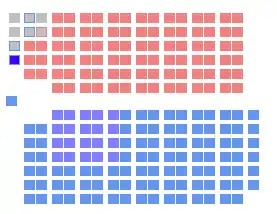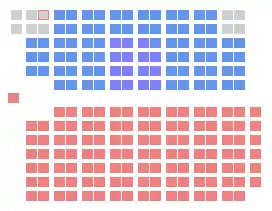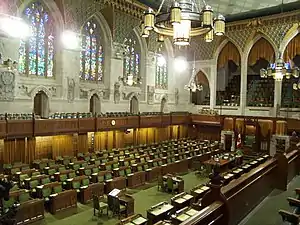
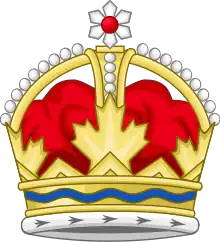 |
|---|
The Parliament of Canada is the legislative body of the government of Canada. The Parliament is composed of the House of Commons (lower house), the Senate (upper house), and the sovereign, represented by the governor general. Most major legislation originates from the House, as it is the only body that is directly elected. A new parliament begins after an election of the House of Commons and can sit for up to five years. The number of seats in parliament has varied as new provinces joined the country and as population distribution between the provinces changed; there are currently 338 House MPs and 105 Senators (when there are no vacancies).
Canada uses a Westminster-style parliamentary government, in which the leader of the party with the most seats in the House of Commons becomes Prime Minister, even if the leader is not an elected member of parliament. The leader of the party with the second-most seats in the House becomes the leader of the Official Opposition, and debate (formally called Oral Questions) between the parties is presided over by the speaker of the House. When the party with the most seats has less than half of the total number of seats, it forms a minority government, which can be voted out of power by the other parties. The Canadian Parliament is located at Parliament Hill in the capital city, Ottawa, Ontario.
Parliaments
Notes
- ↑ The diagrams show the composition of each parliament, colour-coded by party (click on an image to see its key) and arranged as the MPs might sit. The speaker of the house is shown on the left hand side, with the governing party on the speaker's right (the bottom of the diagram) and the opposition on the speaker's left (the top).
- ↑ In Canada's early parliaments, many members of the Conservative Party, including the Prime Minister, used other labels for themselves, the most common being "Liberal-Conservative". The seat totals here is the sum of all labels Conservative Party labels.
- ↑ There were two Independent Conservatives in the 2nd Parliament, giving the government an effective majority.
- ↑ After the 2nd parliament's Pacific Scandal, the Liberals took power between elections.[11]
- ↑ After the dissolution of the 7th Canadian Parliament, Mackenzie Bowell stepped down and Sir Charles Tupper became Prime Minister on May 1, 1896. Tupper was the only Prime Minister during the 1896 election campaign, which he lost, so he was never Prime Minister of a sitting parliament and is therefore not included in this list.[12]
- ↑ During the First World War, Borden governed from a united party with a Cabinet of 12 Conservatives, 9 Liberals and Independents, and 1 "Labour" MP. There were, however, still a number of MPs in opposition to him.[13]
- ↑ In the 14th Parliament, King’s Liberals won exactly enough seats to form a slim majority government, and due to resignations and floor crossing, they shifted back and forth between majority and minority status. However, the government was in little danger of losing a confidence vote because the Progressive party usually allowed free votes among its members, some of whom would always vote with the government.
- ↑ In the 14th parliament, the new Progressive Party led by Thomas Crerar had the second-most seats, yet Arthur Meighen's Conservatives formed official opposition.
- ↑ In the 15th parliament, Mackenzie King's Liberals were initially supported by some members of the Progressive Party of Canada until one of King's appointees in the Department of Customs and Excise was revealed to have taken bribes.
- ↑ In the 15th parliament, Arthur Meighen's Conservatives had the most seats, but Mackenzie King formed the government with the support of the Progressive Party. After the King–Byng Affair, Arthur Meighen's Conservatives took power between elections.
- ↑ In the 16th parliament, Mackenzie King's Liberals were supported by some members of the Progressive Party of Canada, which did not enforce strict party discipline.
- ↑ In the 1940 election, Hanson's Conservative's ran under the name "National Government".
- ↑ In the 26th parliament, Pearson's Liberals were initially supported by Tommy Douglas's New Democratic Party without forming an official coalition.
- ↑ In the 27th parliament, Pearson's Liberals relied on the small opposition parties in order to remain in power without forming an official coalition.
- ↑ In 1990, Prime Minister Brian Mulroney used Section 26 of the Constitution, a never-before used clause, to fill the Senate above its regular limit, giving his party 54 of 112 seats.
- ↑ In the 38th parliament, Martin's Liberals were initially supported by Jack Layton's New Democratic Party without forming an official coalition.
References
- ↑ Canada. "General Elections". Library of Parliament. Retrieved 2011-06-14.
- 1 2 3 4 5 Canada. "Prime Ministers of Canada: Political Information - Governmental Majorities and Minorities". Library of Parliament. Retrieved 2011-10-31.
- ↑ Canada. "Parliaments - Duration of Sessions". Library of Parliament. Retrieved 2011-06-18.
- ↑ Canada. "Key Dates for each Parliament". Library of Parliament. Retrieved 2011-06-18.
- 1 2 Canada. "Duration of Canadian Ministries: 1867 to Date". Library of Parliament. Retrieved 2011-10-31.
- ↑ Canada. "Prime Ministers of Canada". Library of Parliament. Retrieved 2011-06-18.
- ↑ Canada. "Guide to Canadian Ministries since Confederation". Privy Council Office. Archived from the original on 2016-01-05. Retrieved 2011-06-18.
- ↑ Canada. "Party Standings (1980 to Date): In the House of Commons". Library of Parliament. Retrieved 2011-10-31.
- ↑ Canada. "Party Standings (1974 to date): In the Senate". Library of Parliament. Retrieved 2011-10-31.
- 1 2 Canada. "Leaders of the Official Opposition in the House of Commons Since 1873". Library of Parliament. Retrieved 2011-06-18.
- ↑ Terence Allan Crowley; Rae Murphy (1993). Canadian History: Canada Since 1867 Essentials. Research & Education Association. p. 8. ISBN 0-87891-917-1.
- ↑ Frances Stanford (2002). The Prime Ministers of Canada. S&S Learning Materials. p. 24. ISBN 1-55035-721-2.
- ↑ Robert Bothwell; Ian Drummond; John English (1990). Canada, 1900-1945. University of Toronto Press. p. 129. ISBN 0-8020-6801-4.

